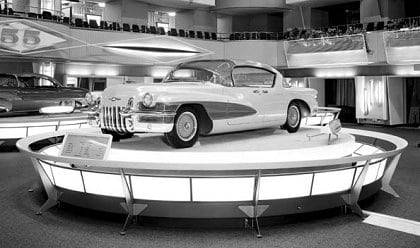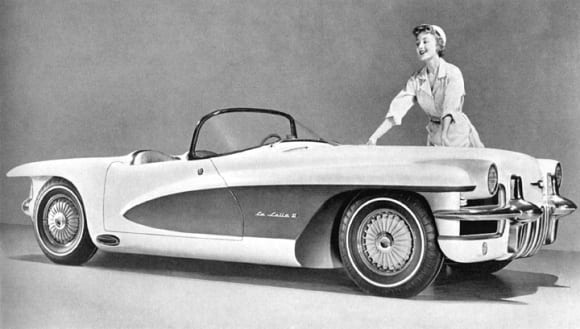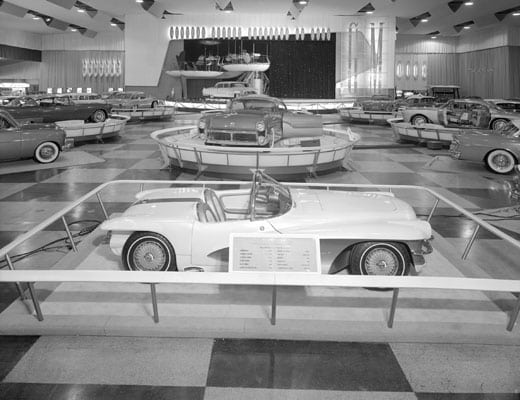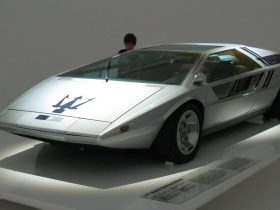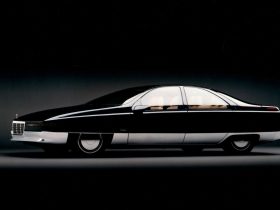The year 1955 was at the center of a pinnacle design era in Detroit, with the American automakers churning out some beautiful vehicles and concepts that showcased the car culture that defined us as a people. It was in this year that General Motors’ annual Motorama show featured two new concepts from design chief Harley Earl that captured much of this lust for automotive: the LaSalle II concepts.
The concepts carried the name of an earlier Cadillac marque that had been popular in the 1930s and retained some styling cues from those early machines that Earl had designed as one of his first projects at GM.
The LaSalle II concepts, a coupe and a roadster, held several design, chassis, and other elements that were revolutionary at the time. Some are still seen in vehicles today.
LaSalle History
While today, we often consider the idea of starting up new marque brands to exploit different market segments to be outdated and a waste of resources, in the 1920s and through to the 1950s, it was the norm in automotive. With brands generally only able to build one or perhaps two models each, sub-branding was common and the leader of that charge was General Motors.
In the mid-1920s, the company saw a gap in the market that they weren’t filling and so they restructured and slotted Cadillac with the LaSalle to fill the price and performance gap between the Oldsmobile Viking and Buick’s Marquette. They turned to newly-hired designer Harley Earl to create the car and in 1927, the first Cadillac LaSalle was introduced.
It came in a full range of body styles, including convertibles, was heavily influenced by the Hispano-Suiza roadsters of the era and was far smaller and more elegant than what Cadillac was building at the time. It became a trend-setter and not only did it implant itself as a popular automobile, it was also a key element in creating the design empire of Harley Earl’s 30 year career at GM.
The LaSalle was built in three generations, with production ending in 1940 when management at GM inexplicably decided to drop the high-selling vehicle in favor of the similar, but lower-priced Packard One-Twenty.
The LaSalle II Design
Conceptual designs of the 1950s had two major themes: bigger is better and smaller is sensational; so cars were generally either huge land yachts or tiny speedsters. The LaSalle II concepts followed the second notion and were a huge splash at Motorama in 1955, being the showcase cars for that year’s show.
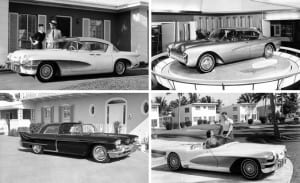 Earl’s aim for the LaSalle II was to create a pair of vehicles worthy of the name that had virtually started his career, but that showcased the style and technology of the mid-1950s. At that time, jet airplanes, space exploration, and modern convenience were the driving forces behind design trends in most industries, automotive included. The LaSalle II concepts took those cues to heart.
Earl’s aim for the LaSalle II was to create a pair of vehicles worthy of the name that had virtually started his career, but that showcased the style and technology of the mid-1950s. At that time, jet airplanes, space exploration, and modern convenience were the driving forces behind design trends in most industries, automotive included. The LaSalle II concepts took those cues to heart.
On first glance, auto lovers will immediately notice that the fender sweep going into the doors looks very familiar. It would become a design cue of some of the most sought-after Corvettes (1956-57 model years). Beyond this obvious design cue, however, there was a lot more going on with the 1955 LaSalles.
The front grille featured vertical bumpers, bullet guards, and LaS emblems from the earlier LaSalle production cars as an homage to them. The fenders also reminisced of those early years, with the open rear wheels of the LaSalle II Roadster evoking images of the first-generation LaSalle designs. The LaSalle II Coupe featured rear-opening (aka “suicide”) doors as another throwback to earlier LaSalle production designs.
The rest of the design cues were all 1950s GM, though. The long, beautiful hood, low roofline, tapered and moulded deck, and integrated rear bumpers were the new ideas that Earl and his team had been working to create as a new trend for GM going forward.
The LaSalle II Coupe featured a tiny 108-inch wheelbase, but still seated six passengers inside. The LaSalle II Roadster stood only 50 inches high thanks to 13-inch tires, a rarity at the time. Its fiberglass body was chopped at the rear end, making it a shorter car overall as it was also a two-door, two-seater. Side rails along the chassis housed the exhaust pipes, which exited just ahead of the rear wheels.
Both cars had what was called “unit construction”, which we now call uni-body construction, and a compound curve windshield that would become a common feature on GM vehicles from 1959 forward. The front-end design would also be seen as inspiration for the 1957 Plymouth after Hal Pilky saw the look.
The Coupe’s design was not much different from many of the four-door designs Earl had been toying with during that period. The Roadster, however, was very unique in many ways. Both vehicles, though, contained elements of earlier designs like the 1954 Buick Wildcat II and Cadillac La Espada and, of course, the 1953 Corvette. Unlike those, however, the LaSalle IIs were meant only as show cars.
Under the Hood
The LaSalle II concepts featured an aluminum small-block V6 that General Motors had been experimenting with during this period. These engines featured what would later be called the “porcupine” valve geometry that became the Daytona-crushing “mystery engine” of 1963. That design became the norm in big block engines from 1965 forward. In general terms, the more valves there are, the more area there is to cool and the smaller the valves can be individually, making it easier to cool the engine without sacrificing power output, thus allowing more power without fear of overheating. The “porcupine” term refers to the cooling fins these multiple valves have.
Where Is It Now?
After their show tours were complete, the LaSalle II concepts were stripped of their drive trains and sent to the crusher. Luckily, neither of them were crushed, but were instead lost in the back corner of a salvage yard, though they had been cut into pieces for transport and eventual crushing.
In the early 1990s, nightclub owner and infamous GM Motorama concept car restorer Joe Bortz found the cars and purchased what was left of them both. He has since put considerable resources into restoring the Roadster, which debuted at the 2008 Pebble Beach Concours d’Elegance in semi-restored condition and again this year at the same show in fully-restored condition with the exception of an electric power train.
Video of the restored car can be viewed here. Below is a video of the showcase cars from the 1955 GM Motorama show, featuring the LaSalle II show cars.
http://youtu.be/5jbgU5xDuj0


